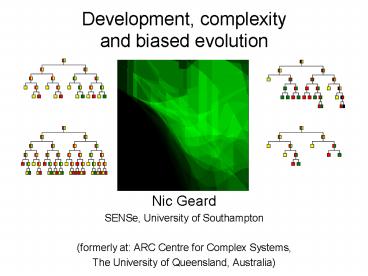Development, complexity and biased evolution PowerPoint PPT Presentation
1 / 20
Title: Development, complexity and biased evolution
1
Development, complexity and biased evolution
- Nic Geard
- SENSe, University of Southampton
- (formerly at ARC Centre for Complex Systems,
- The University of Queensland, Australia)
2
Background
- Recently arrived in the UK to work with Seth
Bullock at University of Southampton - Prior to that, I obtained my PhD from the
University of Queensland in Australia, advised by
Professor Janet Wiles. - Thesis Artificial Ontogenies A Computational
Model of the Control and Evolution of Development
3
Evolution variation and selection
Organism
gene expression, development, environment, etc.
DNA Sequence
4
What role does development play in evolution?
- Developmental reprogramming mutational change
affecting the developmental trajectory of an
organism (Arthur 2002) - If reprogramming is more likely to produce some
trajectories than others, then evolution may be
biased towards those trajectories. - What is a good computational model for studying
developmental reprogramming?
W. Arthur. The emerging conceptual framework of
evolutionary developmental biology, Nature, 2002.
5
How to model developmental space?
- Cell lineages
- Early development of some species is
characterized by invariant patterns of cell
division and differentiation (e.g. C. elegans) - Cell lineages provide a clear record of a
developmental trajectory - An organizational, rather than a morphological,
representation of development
6
Modelling the control of development
- Recurrent neural network model of gene regulation
- Inputs environmental context
- Outputs division and differentiation triggers
- Each cell contains the same network, but with a
different state - Phenotype terminal cells of lineage
7
Measuring developmental complexity
R. Azevedo et al. The simplicity of metazoan cell
lineages, Nature, 2005.
8
How does developmental complexity vary?
- The space of possible developmental trajectories
is vast - By parameterizing the model system, we can
visualise slices through this space - By making the visualisation interactive, we can
efficiently identify major characteristics - LinMap an interactive visualisation tool
N. Geard J. Wiles. LinMap Visualising
complexity gradients in evolutionary space,
Artificial Life, submitted.
9
(No Transcript)
10
Complexity Gradients
?
W
11
Complex behaviour as a transitional phenomenon
12
Different complexity measures
Number of differentiated cells
Number of terminal cells
Weightedcomplexity
Non-deterministic complexity
N8, k8
13
Are all phenotypes equally available for natural
selection?
Traditional view
Developmental bias
W. Arthur. Biased Embryos and Evolution, 2004.
14
Distribution of lineages with two cell fates A
(red) vs B (yellow)
B cells
4 red, 4 yellow
A cells
15
The gene network generates a very different
distribution of frequent phenotypes compared to
a stochastic (Markovian) model
B cells
A cells
16
Features of distribution vary with size and
connectivity
17
What are the implications for evolution?
- Adaptive task Match a cell fate distribution
derived from a biological cell lineage e.g.
C. elegans (male) V6Lpap red hypodermis
green neuron blue apoptosis yellow
structural
18
Dynamic lineages are significantly less complex
than stochastic lineages
real lineage
19
Summary
- A tractable model of development.
- Methods for measuring and visualising the
structure of developmental space. - The intrinsic dynamics of the GRN model result in
some lineages/phenotypes being generated more
frequently than others. - This biased production of variation is reflected
in the direction of adaptation. - A possible explanation for the complexity
observed in real cell lineages (?)
20
Acknowledgements
- Janet Wiles, Kai Willadsen and James Watson
(UQ, Brisbane) - Ricardo Azevedo and Rolf Lohaus (UT, Houston)
Further Information
- LinMap software (Java) and publications available
from http//www.itee.uq.edu.au/nic - Geard, N., (2006). PhD Thesis.
- Geard, N. Wiles, J., (2006). Investigating
ontogenetic space with developmental cell
lineages, Artificial Life X. - Geard, N. Wiles, J., (2005). A Gene Network
Model for Developing Cell Lineages. Artificial
Life 11(3)249-268.

